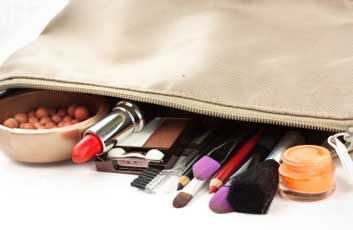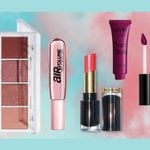The truth about cosmetic preservatives
Do you wonder about the ingredients in your cosmetics? Beauty editor Rhonda Rovan finds out just how safe cosmetic preservatives really are

Source: Best Health Magazine, October 2011
Q: I’ve noticed that many beauty products are labelled "paraben-free." What preservatives are companies using instead’and are they safe?
Rhonda says: One of the bigger quandaries for beauty companies in the past few years has been whether or not their products should contain these synthetic preservatives. Widely used in personal care products for decades, parabens extend a product’s shelf life and stop fungus, bacteria and other microbes from growing in creams and makeup, especially in the moist, warm environment of a bathroom.
However, parabens have been under scrutiny and a cause for consumer alarm ever since a small 2004 U.K. study found traces of it in women with breast tumours. (The study didn’t prove that parabens cause cancer and did not compare paraben levels in normal tissue.) Parabens are also thought to weakly mimic estrogen. As well, some researchers feel they may be endocrine disruptors, and may be implicated in declining sperm counts and increasing rates of male breast cancer and testicular cancer. Government regulators and expert review panels feel more research is needed but, nevertheless, re-jigging product lines has become commonplace.
In 2010, for example, Dermtek, which is based in Dorval, Que., announced that its Reversa skincare line had gone paraben-free. Principessa Beauty, too, has stopped using parabens. This niche makeup and body care company, based in Vancouver, did make its products with parabens when it started up eight years ago, but over time, ‘we started hearing from customers and the stores we supplied who were concerned about parabens,’ says Principessa co-founder Trish Lucarino. So, based on advice from the chemists her company consulted to make its products, she switched to using phenoxyethanol, another synthetic preservative.
Like parabens, phenoxyethanol is ‘an engineered compound that retards the ‘formation of bacterial growth,’ explains Montreal pharmaceutical chemist Ben Kaminsky.
It’s also widely used as a fixative in fragrance. ‘It’s a solvent,’ says David Palmer, head of chemistry at the University of Saskatchewan. ‘It keeps volatile components from evaporating.’
For some in the beauty industry, the evolution away from parabens has been an uneasy one, because they are considered brilliant preservatives that are cost-effective for mass production. Kaminsky, who runs a pharmaceutical manufacturing company and who co-founded the skincare brand ‘B. Kamins, which is manufactured in its own lab in Pointe-Claire, Que., is forthright about why he eliminated parabens: because of consumer pressure. ‘The largest, most prestigious’ health observers in the world’including Health Canada, the FDA and Japan’s Standards for Cosmetics’have never said ‘Stop using parabens.’ ‘And in topical prescriptions, no changes have been made in regard to paraben use.’
Phenoxyethanol isn’t the only substitute, although a scan of products in the Best Health beauty-sample cupboard indicated that it is ubiquitous. Jennifer Kruidbos, a Montreal-based spokesperson for the La Roche-Posay and Vichy skincare brands, lists sodium benzoate, sodium dehydroacetate, sodium sulfate, vitamin E and O-Cymen-5-OL as some alternative preservatives.
‘In this business, you have to choose from a range of preservatives or preservative systems that are appropriate for each product’s emulsion system,’ says Kaminsky, who explains that there is a difference between emulsions where the water dominates, and ones where the oil dominates. ‘It’s not fun. It’s an art to do it properly,’ he says. ‘And, sadly, natural preservatives are not nearly as effective as engineered ones. I have a hard time with them.’
Why are preservatives necessary in cosmetics in the first place? It would be a health risk if there weren’t preservatives in cosmetics and skincare products, points out Darren Praznik, president and CEO of the Canadian Cosmetic, Toiletry and Fragrance Association. ‘Products are stored at room temperature, the formulas are often moist, and they’re going to attract microbes. If they do, and you have a cut in your skin, you could get an infection.’
Kaminsky describes what can happen if a face cream has gone bad: ‘The emulsion will break down, there’ll be discoloration and odour. On open lesions, germs can enter the bloodstream and cause blood poisoning.’
How can companies avoid all that, while still sending preservatives packing’or at least minimizing the necessity of having them? ‘You can hermetically seal a lotion to preserve it,’ says Kruidbos, referring to La Roche-Posay’s Toleriane Ultra, which comes in a pump dispenser with an inner bag. Avène Cream for intolerant skin has similar pristine packaging. So does REN, a U.K.-based face and body care company. But these are stand-alone items or niche brands ‘and besides, they’re not the cheapest items on the shelf.
How about no preservatives? That’s viable for companies producing small batches of products. In Halifax, Sarah Crawley of Soap Girl says, ‘All of our products are preservative-free, since they don’t contain water. When there’s water in a formulation, preservatives need to be added to keep the integrity of the product. We also have a dry powder mask that can be mixed when you are ready to use it; since it’s a dry powder, preservatives are not required.’
Interestingly, going preservative-free is also viable in glycolic acid skin care where the percentage of glycolic acid is eight to 10 percent and the pH balance is 3.8, says Dermtek president Robert Lavoie.’We never had preservatives in our eight to 10 percent glycolic acid products. And in recent tests we discovered that when the pH is 3.8, no preservatives are needed where the glycolic acid is lower.’ In Reversa’s new Multi-Tasking Care line, which is not a glycolic acid formula, the preservatives are potassium sorbate and phenoxyethanol.
At Green Beaver, an organic and natural personal care company in Hawkesbury, Ont., microbiologist and co-founder Alain Ménard says, ‘About half of our products are made without any preservatives because there’s no water in them’products that are oil and wax based like lip balms. In the case of toothpaste, which does contain water, we use glycerine, which prevents the paste from forming microbes.’ For creams and lotions”they’re the toughest”he uses various combinations of natural preservatives such as turmeric, clove bud, oregano, thyme, rosemary, goldenseal root, grapefuit seed extract, lavender oil and lemon grass.
Many natural preservatives are not practical for cosmetics because it would require a high quantity to make them work. ‘The issue of relative amount is important,’ says Palmer. Consumers are very particular about texture and smell, he says. ‘Imagine lipstick that didn’t feel right going on and smelled vaguely of turmeric. Phenoxyethanol can be used in much smaller amounts than natural preservatives.’
But Ménard feels that after parabens, phenoxyethanol is going to be ‘the next target. It’s a question of time’ until it is no longer used in products. For organic manufacturers like Ménard, it has become a greenwashing lightning rod because many companies that use ‘paraben-free’ as a marketing platform or that position themselves as ‘natural’ have phenoxyethanol in their ingredient lists. ‘They’ve traded in one synthetic preservative for another.’
In Ménard’s opinion, phenoxyethanol should be avoided. ‘It is restricted for use in cosmetics in Japan, which is always ahead of the curve when it comes to cosmetic safety,’ he says. (He finds the website of the Environmental Working Group in the U.S. to be a good source about phenoxyethanol’s toxicity.)
What’s more, Ménard notes, ‘Many companies have traded parabens for another class of chemical preservatives called ‘formaldehyde slow releasers.”’ He says these appear on ingredient lists as quaternium-15, DMDM hydantoin, imidazolidinyl urea and diazolidinyl urea. Health Canada allows the use of formaldehyde in cosmetics at levels of no more than 0.2 percent. ‘The problem is, we all use more than one product a day,’ says Ménard, and that can add up.
In June 2008, Health Canada issued an advisory not to use Mommy’s Bliss Nipple Cream, which was designed to soothe cracked dry nipples, and was being promoted as all-natural. Phenoxyethanol in the formula was one of the reasons the product posed a side-effect risk to nursing infants. Phenoxyethanol ‘can slow down the brain function. It may cause vomiting and diarrhea, which can lead to dehydration in infants,’ stated Health Canada.
But, says Palmer, ‘the ban on nipple cream got people’s attention, and then [phenoxyethanol] was indicted by association’. There is a huge toxicological difference between an infant ingesting something and an adult rubbing it on his or her skin.’ As for slow-release formaldehyde compounds, ‘the danger would come from high doses, or heating [which would speed up the release], or possibly if they were stored for a very long time,’ says Palmer.
‘I think phenoxyethanol is not something most people should worry about,’ he says. ‘I think ‘may cause irritation’ is the most accurate description of the dangers of the compound in the doses you are looking at.’
Principessa’s Lucarino, for her part, feels a lot of ‘misinformation’ is being spread on the Internet, so she sticks with the advice of her chemists, who say that it’s safe to use phenoxyethanol in the miniscule amounts required in her products.
Stay tuned for further developments.
What are you curious about? Send your beauty questions to Rhonda at besthealthmag.ca/askRhonda or @RhondaRovan on Twitter.




